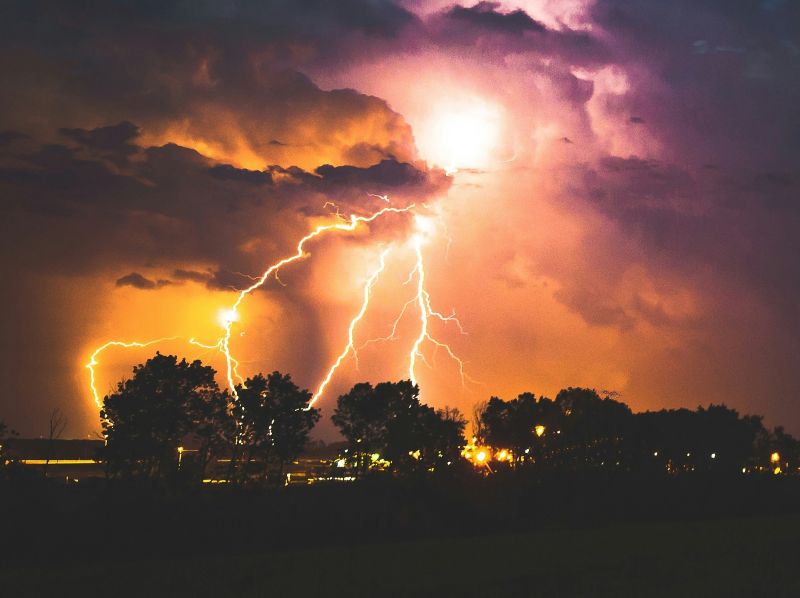8-minute read
Quick summary: A four-phase approach to wildfire mitigation that helps utilities assess, prioritize, and reduce wildfire risks effectively
Wildfire risk is no longer a distant threat—it’s an immediate and growing liability. The escalating threat of wildfires caused by utility infrastructure has become more pronounced in recent years, with increasing frequency and severity of incidents that utilities must urgently address. Recent enforcement actions across multiple utilities have highlighted challenges related to compliance with Public Safety Power Shutoff (PSPS) program requirements and vegetation management practices. These violations underscore the critical need for proactive risk management to prevent wildfires, protect communities, and avoid substantial financial penalties. Wildfires can cause billions of dollars in damage to communities and bankrupt utilities, emphasizing the importance of robust wildfire risk mitigation efforts.
These enforcement actions follow a national trend: recent catastrophic wildfires have caused significant loss of life, destroyed thousands of structures, and resulted in billions of dollars in damage. Investigations suggest that at least some of these fires may have been caused by downed power lines—highlighting how utility infrastructure failures can be catastrophic. Catastrophic wildfire events, including catastrophic power line fires, have demonstrated the potential for extensive damage, loss of life, and long-term economic impact.
As wildfire risk expands into areas with no historical precedent, utilities are under increasing pressure to act. Many are ramping up public safety power shutoff (PSPS) programs and grid hardening initiatives, but these efforts must be grounded in comprehensive data, robust risk modeling, and disciplined execution. Utilities that succeed in managing elevated wildfire risk will embrace dynamic risk assessments that inform both long-term planning and adaptive strategies to address changing conditions. Dry conditions and climate change have significantly contributed to the spread of wildfire risk into new areas, transforming previously low-risk regions into high-risk zones. Cutting corners on vegetation management, inspection documentation, or PSPS implementation can now cost millions, even if there’s no ignition. That’s why wildfire risk modeling and a fully implemented Wildfire Mitigation Plan (WMP) are no longer optional, they’re essential for regulatory compliance, operational safety, and long-term resilience.
The growing frequency of wildfires is beginning to pose significant challenges for utility providers in regions that have not historically faced these risks. For utilities looking to prepare for regulatory changes and invest in WMP initiatives that deliver incremental value across the organization, we recommend a four-phase approach to achieving risk awareness that is founded in data and analytics.
Example of a Public Safety Power Shutoff (PSPS) dashboard
Effective mitigations, like public safety power shutoff programs and strategic grid hardening initiatives, can drastically reduce the likelihood of a utility-caused ignition and enable utilities to provide safe, reliable power to their communities. Enhanced real-time data collection improves effective PSPS decision-making for utilities, allowing them to act swiftly and minimize disruptions caused by fire.
Regulatory compliance is increasingly complex, especially in California, where the California Public Utilities Commission (CPUC) has established stringent requirements for utilities to assess and mitigate wildfire hazards, develop wildfire mitigation plans, and incorporate risk modeling methodologies influenced by state policies and regulations.
The Edgewood Fire and other utility-caused ignitions highlight the risks posed by power lines as a source of ignition, especially under dry conditions and the escalating threat of catastrophic wildfires.
Four-phase risk-aware approach to wildfire mitigation planning
Our structured approach to wildfire mitigation provides a robust framework that utilities can use to proactively manage and reduce wildfire risk, starting from the ground up. This approach serves as a comprehensive wildfire risk management strategy for utilities, addressing the unique challenges of utility wildfire risk through systematic planning and execution. Each phase is driven by predictive intelligence and advanced analytics to ensure utility investment is guided by comprehensive, trustworthy insights, with a strong emphasis on prioritizing mitigation efforts to protect assets and communities.
Phase 1: Defining risk
Defining risk is central to any modeling initiative. Risk definitions, drivers, scenarios, and mitigations will be the bedrock of the risk methodology that a utility designs and uses to operationalize their data for decision making. Identifying key risk drivers and potential failure modes is essential to fully understand wildfire risk in utility operations, as this enables more accurate risk assessment and effective mitigation strategies.
Objective: Coalesce on a shared understanding of risk
A wildfire mitigation program spans the entire utility and has applications in asset management, vegetation management, emergency response, community outreach, grid ops, and more. Because of the cross-cutting nature of wildfire mitigation, we recommend a utility start their program by defining what risk means to their organization.
This can be done by establishing the model’s pillars of safety, reliability, and financial feasibility. Defining risk at a high level and distilling risk into drivers and scenarios helps to make clear exactly what problems the utility is looking to solve with risk modeling and what kinds of programs and initiatives might be the focus of the WMP. Potential use cases and WMP initiatives are likely to be identified through this process.
Outcome: The foundational call to action of the WMP is established
With a high-level methodology outlined and potential uses cases and program initiatives identified, the utility is poised to begin planning more specific investments and determining how it will begin to prove value and iterate on its risk modeling capabilities.
WEBINAR
Register today:
Phase 2: Catalyzing risk response
Objective: Align and adapt enterprise risk management (ERM) processes to the WMP
Working across the utility to gain alignment with existing enterprise risk management processes and risk modeling capabilities, define a risk management framework that will guide how the WMP identifies, assesses, and responds to risk. This is an exercise in creating a tactical framework to operationalize insights from risk modeling and apply them to decision making. Using various “levers” such as vegetation clearing and grid hardening initiatives, the utility can generate concrete results such as fewer outages from vegetation contact and a reduced risk of utility-caused ignitions.
It is also an opportunity to gain buy-in for the WMP and initiate a transformational change management process. Utilities that take the time to outline an ERM framework have a clearer pathway towards sourcing use cases, generating useful insights, and planting the seeds for an efficient, sustainable program.
Outcome: A process to operationalize risk intelligence insights across the utility
A WMP is a matrixed, cross-functional program that spans the entire utility. An ERM framework that aligns to the goals and approaches of the WMP sets a process for communicating risk across the utility and ensuring risks have a clear path toward assessment, monitoring, and mitigation.
Using various “levers” such as vegetation clearing and grid hardening initiatives, the utility can generate concrete results such as fewer outages from vegetation contact and a reduced risk of utility-caused ignitions.
Phase 3: Building a risk landscape
A comprehensive view of wildfire risk unites information about utility grid assets with information about the geographic areas and environments where assets are located. Utilities want to know if an asset is located near dry vegetation, if it is a part of a circuit that powers a hospital or school or serves vulnerable customers, if it is subject to high winds—the list goes on and on. While many utilities have data that describes their assets, such as asset type, location, and material, many do not have reliable, comprehensive data on geography, weather, and climate conditions. Incorporating fuel moisture, forecasted weather, and outage data into risk models is essential for accurately assessing wildfire ignition likelihood and spread, and for prioritizing mitigation strategies. Additionally, utilities may not have the technology infrastructure required to put all of this data together and distill it into a format that lends itself easily to insights and decision making.
Step 3 involves mapping out where in the service territory wildfire risk is most significant and determining the potential consequence of a wildfire ignition. This phase employs geospatial risk models that integrate multiple data sources—such as asset, vegetation cover, fuel loading, and topography—to visualize risk across a utility’s service territory. By pinpointing hazardous areas, the utility can prioritize high-risk zones and lay the groundwork for targeted mitigation strategies.
Objective: Generate asset-level risk scores and rankings for targeted mitigation
Using the risk definitions, drivers, and scenarios from Phase 1, we develop wildfire risk models that use high-quality data to reliably forecast wildfire risk. Advanced modeling integrates weather forecasts to provide situational awareness of wildfire risks, enabling utilities to anticipate and respond to potential threats more effectively. The predictions from these risk models can be applied to a variety of use cases and often use similar data and business logic.
Utilities that are projecting wildfire risk decades into the future may choose to develop a model that simulates climate changes and considers grid investments and construction projects, with the goal of incorporating insights into strategic planning. Utilities that are currently experiencing heightened wildfire risk conditions or that expect conditions to arise soon may focus on building models that can support emergency response or inform public safety power shutoffs.
Outcome: Risk insights that drive the WMP
With the risk landscape established, the utility has a clear understanding of where risk exists in the service territory, the factors that influence and drive the risk, and potential mitigations that can reduce the risk. Risk predictions are typically made at an asset level of granularity—for instance, circuit, segment, or span—and can be viewed on a map interface where risk scores are overlaid onto the grid alongside asset information. More mature utilities may invest in platforms that offer a more incisive view of the grid and enable an interactive exploration of risk scores that can be adjusted for scenario-based, “what if?” analysis. These types of platforms can be built iteratively in step with IT investment in data management, data governance, advanced analytics, and beyond.
Phase 4: Operationalizing risk awareness
Iteration and improvement is paramount to an effective WMP and crucial to developing risk modeling tools and technologies. These four phases link together into a cycle-driven, repeatable process that can be followed to refresh the WMP on an annual basis and introduce new initiatives and use cases.
The final phase synthesizes insights from the first three phases to develop a strategic WMP that is both actionable and scalable. Actionable insights derived from advanced data analysis drive infrastructure investments and inform strategies to protect utility assets, ensuring that financial resources are allocated to the most effective resilience measures. This phase involves outlining specific initiatives to address identified risks—such as vegetation management and grid hardening—while also setting benchmarks for continual improvement. With a data-driven roadmap in place, utilities can implement mitigative actions, track progress, and refine their approach over time to ensure long-term resiliency against wildfire threats.
Objective: Formulate a comprehensive WMP with strategic goals and a maturity roadmap
We develop a wildfire mitigation plan that translates insights from previous phases into concrete actions and long-term strategies. This phase ensures that the utility is equipped with a strategic, adaptable roadmap for both immediate and sustained wildfire risk reduction.
Outcome: Synergistic WMP programs and initiatives
The comprehensive, actionable WMP provides a roadmap for both short- and long-term wildfire mitigation. This plan enables the utility to manage wildfire risks proactively, with structured goals and benchmarks that facilitate ongoing evaluation and refinement. By aligning immediate actions with future objectives, the WMP supports a resilient, adaptable approach to wildfire mitigation that can evolve alongside changing risk landscapes.
Building a resilient approach to wildfire risk
As wildfire threats intensify, a proactive, data-driven approach to wildfire mitigation is no longer optional for utilities—it’s essential. Through our four-phase framework, utilities can strategically assess, prioritize, and address wildfire risks, ensuring that resources are allocated effectively to safeguard communities, assets, and the environment. For electric utilities, it is critical to evaluate electric utility operations and address utility wildfire and asset caused wildfires to minimize harm to infrastructure, public health, and communities. From mapping geographic risk to developing asset-specific models and implementing a robust wildfire mitigation plan, each phase builds on the last to create a comprehensive strategy that is both scalable and adaptive.
By leveraging predictive intelligence and advanced analytics, utilities are not only preparing for the wildfire risks of today, but also positioning themselves to respond to future challenges with agility. Our approach provides the tools needed to anticipate risk, direct investments wisely, and maintain operational resilience in the face of evolving wildfire threats. Embracing a structured, phased strategy for wildfire mitigation helps utilities meet regulatory expectations, protect their service areas, and build a safer, more reliable grid for the communities they serve.

Building resilience through risk management
- Enterprise risk management frameworks
- Advanced data and analytics
- Regulatory compliance solutions
- Grid resilience planning
- Predictive risk modeling


Alexander Johnson is a Machine Learning Architect in Logic20/20’s Advanced Analytics practice. Specializing in wildfire risk modeling for utilities, Alex combines expertise in advanced analytics, cloud engineering, and machine learning to develop impactful solutions. With a background in environmental science and GIS, he brings a unique perspective to wildfire mitigation planning, leveraging data-driven approaches to enhance utility operations and manage risk effectively.

